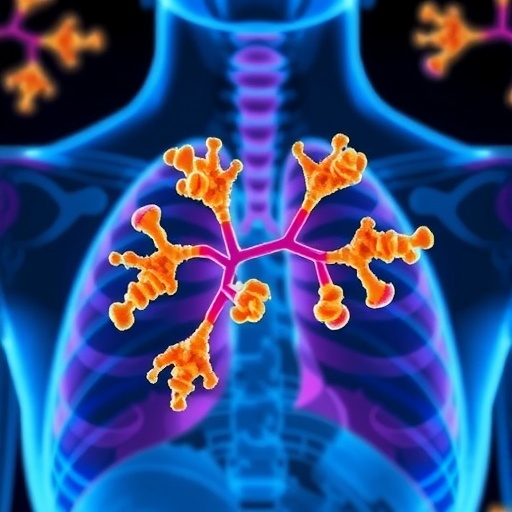
In recent years, tuberculosis (TB) has continued to pose a substantial public health challenge worldwide, primarily due to the emergence of drug-resistant strains and the inadequacies of existing treatments. A striking study conducted by Suvaiv, Singh, Hasan, and their colleagues has introduced a transformative approach to tackling this pervasive disease. Their research emphasizes the design, synthesis, and biological evaluation of coumarin derivatives as a therapeutic strategy against TB, utilizing a pharmacophore-based approach that could pave the way for novel treatment options.
The research team has invested immense efforts into exploring the antibacterial properties of coumarin derivatives, organic compounds known for their diverse biological activities, including antibacterial, antifungal, and antiviral effects. By leveraging the structural characteristics of coumarins, the researchers sought to develop compounds that could effectively inhibit the growth of Mycobacterium tuberculosis, the bacterium responsible for TB. This innovative approach could significantly alter the landscape of TB treatment, potentially offering patients more effective therapies with fewer side effects.
Beginning with a thorough literature review, the researchers identified the core pharmacophoric features crucial for effective antibacterial action. They meticulously examined existing coumarin derivatives, noting their chemical structures and the biological activities associated with them. This background knowledge laid the groundwork for a rational design strategy aimed at synthesizing new compounds that retained the beneficial properties of their precursors while enhancing efficacy against TB.
Following the identification of essential pharmacophoric elements, the team synthesized a series of novel coumarin derivatives. The synthesis process involved strategic modifications to the coumarin scaffold, allowing for the introduction of various substituents that could enhance antibacterial potency. During synthesis, the researchers employed advanced organic chemistry techniques, ensuring that the resulting compounds maintained optimal stability and bioavailability.
To assess the biological activity of these synthesized derivatives, the researchers conducted comprehensive in vitro screening assays against Mycobacterium tuberculosis. By employing several concentrations of the compounds, they quantified their inhibitory effects, identifying lead candidates that exhibited significant antibacterial properties. The precision of these evaluations was paramount, as the findings would ultimately guide the selection of compounds for further testing and optimization.
In addition to evaluating the antibacterial efficacy of the coumarin derivatives, the research also delved into investigating their pharmacokinetic profiles. Understanding how each compound is absorbed, distributed, metabolized, and excreted within biological systems is crucial for determining its viability as a therapeutic agent. The researchers meticulously analyzed these factors, shedding light on the potential commercial applicability of their coumarin derivatives as alternative TB treatments.
The team also prioritized the safety of their synthesized compounds, conducting cytotoxicity assays to ensure that the coumarin derivatives would not pose detrimental effects to human cells. The implications of these tests are profound; effective TB treatments must be both efficient at combating the bacteria and safe for patient administration. Thus, by confirming the low cytotoxic profiles of their lead compounds, the researchers took an important step toward realizing their therapeutic potential.
In their study, the researchers recognized the importance of collaboration and interdisciplinary research efforts in addressing the multifaceted challenge of TB. By integrating advanced medicinal chemistry techniques, microbiology, and pharmacology, they exemplified how a multidisciplinary approach can accelerate the discovery of novel therapeutic agents. This mindset not only reflects the current trends in scientific exploration but also underscores the necessity for unity in academia and industry to combat rising health threats.
The potential for coumarin derivatives to become a linchpin in TB treatment is encouraged by their diverse mechanism of action. The researchers indicated that these compounds may disrupt essential bacterial processes, including DNA replication and cell wall synthesis, which are critical for the proliferation of Mycobacterium tuberculosis. This multifaceted approach could mitigate the risk of bacterial resistance, an ever-looming concern within infectious disease management.
Moreover, the research highlights the need for ongoing evaluation and optimization of the coumarin derivatives as they progress through various stages of drug development. The timeline for transforming a promising compound into a marketed therapy is fraught with challenges, including the necessity for extensive clinical trials to ascertain safety and efficacy in human populations. The researchers emphasized their commitment to continue this journey, actively seeking collaborations to facilitate the translation of their lab discoveries into real-world therapeutic options.
As the battle against tuberculosis continues, studies such as this serve as beacons of hope, illustrating the possibilities that exist within organic chemistry and pharmacology for addressing unmet medical needs. The proactive steps taken by Suvaiv and colleagues signify a hopeful direction in the advancement of TB therapeutics, echoing a commitment to enhancing global health.
The challenges posed by tuberculosis are numerous, but with innovative approaches and strategic scientific investigation, the journey towards more effective drug therapies continues to evolve. The researchers aspire to inspire future studies that could lead to breakthroughs in not only TB treatment but also broader infectious disease management. Their findings will provide a pivotal platform for future experimentation and exploration in this critical area of public health.
As the final phases of research are underway, anticipation builds for the impact these findings may have on clinical practices globally. The hope is that the world will soon see coumarin derivatives enter the pharmaceutical arena as reliable treatment options for those afflicted by tuberculosis, contributing to the fight against this resilient pathogen.
In summary, the work by Suvaiv and colleagues unveils a promising path forward in tuberculosis research. With careful attention to scientific rigor and a commitment to unraveling the complexities surrounding the disease, they have laid down a foundation of hope and innovation that could reshape the future of TB treatment. Continued support for such research endeavors will be essential in overcoming the obstacles posed by this ancient disease that continues to plague modern society.
Subject of Research: Design and evaluation of coumarin derivatives for tuberculosis treatment.
Article Title: Design, synthesis, and biological evaluation of coumarin derivatives against tuberculosis: a pharmacophore-based approach.
Article References:
Suvaiv, Singh, K., Hasan, S.M. et al. Design, synthesis, and biological evaluation of coumarin derivatives against tuberculosis: a pharmacophore-based approach.
Mol Divers (2025). https://doi.org/10.1007/s11030-025-11293-5
Image Credits: AI Generated
DOI: 10.1007/s11030-025-11293-5
Keywords: Tuberculosis, coumarin derivatives, pharmacophore, antibacterial, drug resistance.
Tags: antibacterial properties of coumarinscoumarin compounds biological evaluationcoumarin derivatives in medicinedrug-resistant tuberculosis solutionsemerging therapies for infectious diseasesnew treatments for Mycobacterium tuberculosisnovel antibiotic development strategiespharmacophore-based drug designpublic health challenges tuberculosisresearch on drug-resistant infectionssynthetic organic chemistry in healthcaretuberculosis treatment innovations




